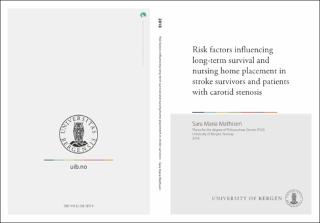| dc.contributor.author | Mathisen, Sara Maria | en_US |
| dc.date.accessioned | 2018-06-08T09:23:23Z | |
| dc.date.available | 2018-06-08T09:23:23Z | |
| dc.date.issued | 2018-01-11 | |
| dc.identifier.isbn | 978-82-308-3870-9 | en_US |
| dc.identifier.uri | https://hdl.handle.net/1956/17759 | |
| dc.description.abstract | Risk factors influencing long-term survival and nursing home placement in stroke survivors and patients with carotid stenosis Stroke is one of the leading causes of mortality and morbidity worldwide and one of the most devastating of all neurological conditions. Due to the many advances that have been made in terms of prevention and mortality in cardiovascular diseases, the mortality from stroke has declined steadily and more patients survive their strokes. Short-term mortality is intensely studied. Knowledge of long-term mortality and its clinical predictors offers the opportunity to better control the risk factors in the follow-up after a stroke. We have investigated long-term survival for up to 12.8 years and causes of death in 230 patients with ≥40 % ICA-stenosis that is a known risk factor for stroke regarding statin treatment. The results indicate that use of statins seems to increase long-term survival in patients with established carotid artery stenosis significantly compared to patients not using statins. We also examined the long-term mortality for up to 16.4 years in 1137 patients with acute stroke and compared it to a matched, stroke-free control group. We identified risk factors present at index stroke that might predict long-term mortality. The results indicate that stroke patients surviving the first year after stroke have a markedly increased but stable mortality rate during long-term follow-up compared to stroke free controls. Changes in creatinine, homocysteine and glucose could be addressed more aggressively as a standard routine after acute stroke. The 452 patients belonging to the municipality of Stavanger were followed for up to 15.4 years regarding nursing home placement (NHP). Almost 90% of the stroke patients could initially be discharged to their homes but they needed earlier and more often NHP in the long run than the stroke-free controls, but they did not stay longer. | en_US |
| dc.language.iso | eng | eng |
| dc.publisher | The University of Bergen | eng |
| dc.relation.haspart | Paper I: Wörlund SM, Kurz MW, Hegland O, Brønnick K, Munk PS, Larsen JP. Treatment with statins improves long-term survival in individuals with carotid artery stenosis. Int J Cardiol. 2013 Sep 20;168(1):624-6. <a href="https://doi.org/10.1016/j.ijcard.2013.01.198" target="blank">https://doi.org/10.1016/j.ijcard.2013.01.198</a> | en_US |
| dc.relation.haspart | Paper II: Mathisen SM, Dalen I, Larsen JP, Kurz M. Long-Term Mortality and Its Risk Factors in Stroke Survivors. J Stroke Cerebrovasc Dis. 2016 Mar;25(3):635-41. <a href="http://dx.doi.org/10.1016/j.jstrokecerebrovasdis.2015.11.039" target="blank">http://dx.doi.org/10.1016/j.jstrokecerebrovasdis.2015.11.039</a> | en_US |
| dc.relation.haspart | Paper III: Mathisen SM, Larsen JP, Kurz MW. The prognosis of stroke survivors primarily discharged to their homes. Acta Neurol Scand. 2017 Jan 27. <a href="https://doi.org/10.1111/ane.12731" target="blank">https://doi.org/10.1111/ane.12731</a> | en_US |
| dc.rights | All rights reserved. | eng |
| dc.title | Risk factors influencing long-term survival and nursing home placement in stroke survivors and patients with carotid stenosis | en_US |
| dc.type | Doctoral thesis | |
| dc.rights.holder | Copyright the author. All rights reserved. | |
| dc.subject.nsi | VDP::Medisinske Fag: 700::Klinisk medisinske fag: 750 | en_US |
